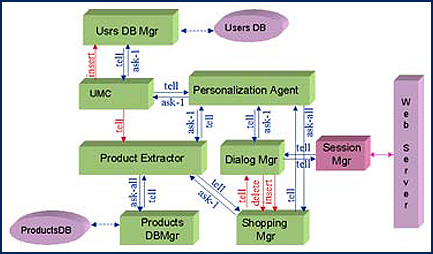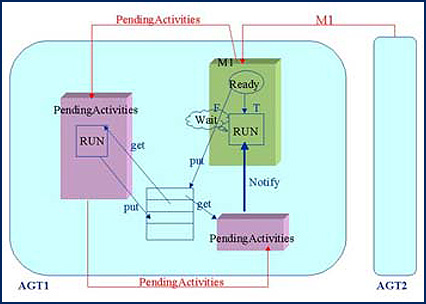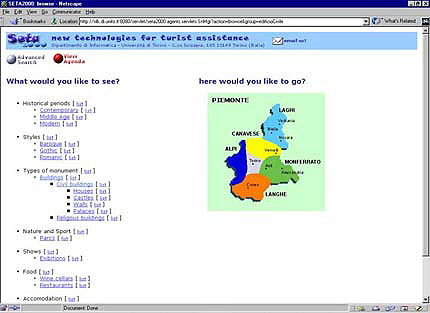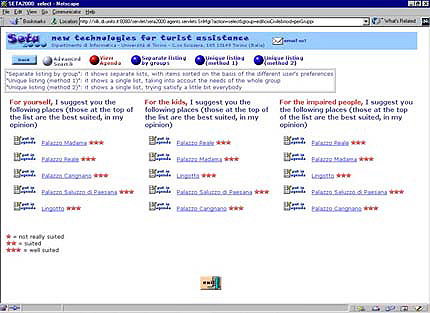Intelligent User Interfaces Home >>>research>>>INTRIGUE
INTRIGUEThe project focused on the re-design of the multi-agent architecture developed within the SETA project to build adaptive Web based systems. This architecture represents an evolution of the SETA architecture and differs for the internal design of the system agents. In INTRIGUE (INteractive TouRist Information GUidE), an agent-communication infrastructure has been developed to enable a uniform communication among heteregeneous agents, which can communicate in synchronous and asynchronous ways. This infrastructure supports the design of internal agent architectures which can behave according to different paradigms: they can offer services by method execution, in a pure Object-Oriented style, but they can also carry on internal activities in an autonomous way.  The basic principles behind the design are:
A set of specialized agents have been defined. Each of them has a key role (for instance, the communication with the Web, page generation, etc.) and manages the related activities, using knowledge and technologies specific to the task. In particular the architecture includes:
 The activity of the project involved also the definition of the internal architecture of a single agent. This architecture has been designed to allow the interaction of heterogeneous agents and includes a wrapper to allow a unified message protocol between differend kind of agents. The protocol includes syncronous, asyncronous and multicast types of messages. Moreover, the wrapper allows the agents to manage requests in parallel using the Java thread mechanism. Internally the agents can follow different paradigms: action-based or standard Java objects. The User Modeling component needs to provide user data to other agents but also has some autonomous activities to carry on such as revising the user model, during the interaction with the system: these activities should be managed indipendently from the other agents requests. Other agents, like the Personaliation Agent, responsible for building the personalized Web pages, should respond to requests from the browser. A prototype for personalized tourism services on the Web has been build following the revised architecture. The system presents to the user artistic attractions as well as restaurants or other useful services. The navigation of the touristic site can be done on the basis of different criteria: information can be found geographically or searching by categories (museums, buildings, restaurants, etc.) or combining the two strategies, for example the user can search for all the Baroque buildings in Torino.  INTRIGUE tailors the suggestion of touristic attractions to the user's interests and requirements, taking into account the fact that, in addition to individual users, also groups of people might want to plan a trip together. In order to handle this issue, the system maintains a model of the group of tourists and tailors the suggestions to the requirements of the possibly heterogeneous (e.g., the group might include people having extremely different requirements, such as audults, children, disabled people). The system also offers specific problem-solving functionalities to coordinate the visit to the suggested places, recommending visits during the opening times of the various places.  The system has reasoning capabilities since it is able to schedule the visit during a day by taking into account both the user's choices and other constraints. In particular, the system allows the user to select and insert in the agenda a set of artistic attractions of interest and ask the system to organize the plan of the day on the basis of the selected items and other constraints the user might have (for example the starting time of the visit, morning or afternoon preferences). Relevant papers:
For more information about this project, please
contact
|





